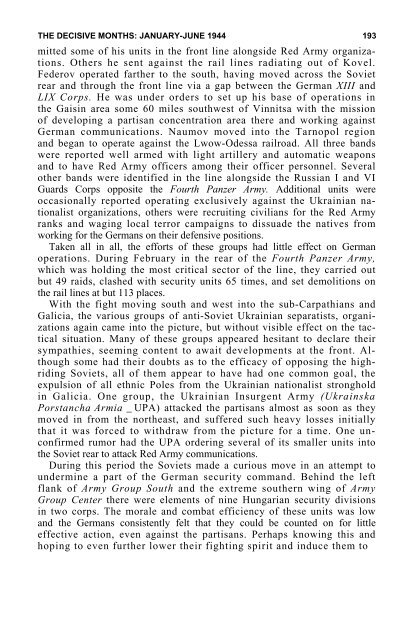the soviet partisan movement 1941-1944 by edgar m. howell
the soviet partisan movement 1941-1944 by edgar m. howell
the soviet partisan movement 1941-1944 by edgar m. howell
You also want an ePaper? Increase the reach of your titles
YUMPU automatically turns print PDFs into web optimized ePapers that Google loves.
THE DECISIVE MONTHS: JANUARY-JUNE <strong>1944</strong> 193<br />
mitted some of his units in <strong>the</strong> front line alongside Red Army organizations.<br />
O<strong>the</strong>rs he sent against <strong>the</strong> rail lines radiating out of Kovel.<br />
Federov operated far<strong>the</strong>r to <strong>the</strong> south, having moved across <strong>the</strong> Soviet<br />
rear and through <strong>the</strong> front line via a gap between <strong>the</strong> German XIII and<br />
LIX Corps. He was under orders to set up his base of operations in<br />
<strong>the</strong> Gaisin area some 60 miles southwest of Vinnitsa with <strong>the</strong> mission<br />
of developing a <strong>partisan</strong> concentration area <strong>the</strong>re and working against<br />
German communications. Naumov moved into <strong>the</strong> Tarnopol region<br />
and began to operate against <strong>the</strong> Lwow-Odessa railroad. All three bands<br />
were reported well armed with light artillery and automatic weapons<br />
and to have Red Army officers among <strong>the</strong>ir officer personnel. Several<br />
o<strong>the</strong>r bands were identified in <strong>the</strong> line alongside <strong>the</strong> Russian I and VI<br />
Guards Corps opposite <strong>the</strong> Fourth Panzer Army. Additional units were<br />
occasionally reported operating exclusively against <strong>the</strong> Ukrainian nationalist<br />
organizations, o<strong>the</strong>rs were recruiting civilians for <strong>the</strong> Red Army<br />
ranks and waging local terror campaigns to dissuade <strong>the</strong> natives from<br />
working for <strong>the</strong> Germans on <strong>the</strong>ir defensive positions.<br />
Taken all in all, <strong>the</strong> efforts of <strong>the</strong>se groups had little effect on German<br />
operations. During February in <strong>the</strong> rear of <strong>the</strong> Fourth Panzer Army,<br />
which was holding <strong>the</strong> most critical sector of <strong>the</strong> line, <strong>the</strong>y carried out<br />
but 49 raids, clashed with security units 65 times, and set demolitions on<br />
<strong>the</strong> rail lines at but 113 places.<br />
With <strong>the</strong> fight moving south and west into <strong>the</strong> sub-Carpathians and<br />
Galicia, <strong>the</strong> various groups of anti-Soviet Ukrainian separatists, organizations<br />
again came into <strong>the</strong> picture, but without visible effect on <strong>the</strong> tactical<br />
situation. Many of <strong>the</strong>se groups appeared hesitant to declare <strong>the</strong>ir<br />
sympathies, seeming content to await developments at <strong>the</strong> front. Although<br />
some had <strong>the</strong>ir doubts as to <strong>the</strong> efficacy of opposing <strong>the</strong> highriding<br />
Soviets, all of <strong>the</strong>m appear to have had one common goal, <strong>the</strong><br />
expulsion of all ethnic Poles from <strong>the</strong> Ukrainian nationalist stronghold<br />
in Galicia. One group, <strong>the</strong> Ukrainian Insurgent Army (Ukrainska<br />
Porstancha Armia _ UPA) attacked <strong>the</strong> <strong>partisan</strong>s almost as soon as <strong>the</strong>y<br />
moved in from <strong>the</strong> nor<strong>the</strong>ast, and suffered such heavy losses initially<br />
that it was forced to withdraw from <strong>the</strong> picture for a time. One unconfirmed<br />
rumor had <strong>the</strong> UPA ordering several of its smaller units into<br />
<strong>the</strong> Soviet rear to attack Red Army communications.<br />
During this period <strong>the</strong> Soviets made a curious move in an attempt to<br />
undermine a part of <strong>the</strong> German security command. Behind <strong>the</strong> left<br />
flank of Army Group South and <strong>the</strong> extreme sou<strong>the</strong>rn wing of Army<br />
Group Center <strong>the</strong>re were elements of nine Hungarian security divisions<br />
in two corps. The morale and combat efficiency of <strong>the</strong>se units was low<br />
and <strong>the</strong> Germans consistently felt that <strong>the</strong>y could be counted on for little<br />
effective action, even against <strong>the</strong> <strong>partisan</strong>s. Perhaps knowing this and<br />
hoping to even fur<strong>the</strong>r lower <strong>the</strong>ir fighting spirit and induce <strong>the</strong>m to
















